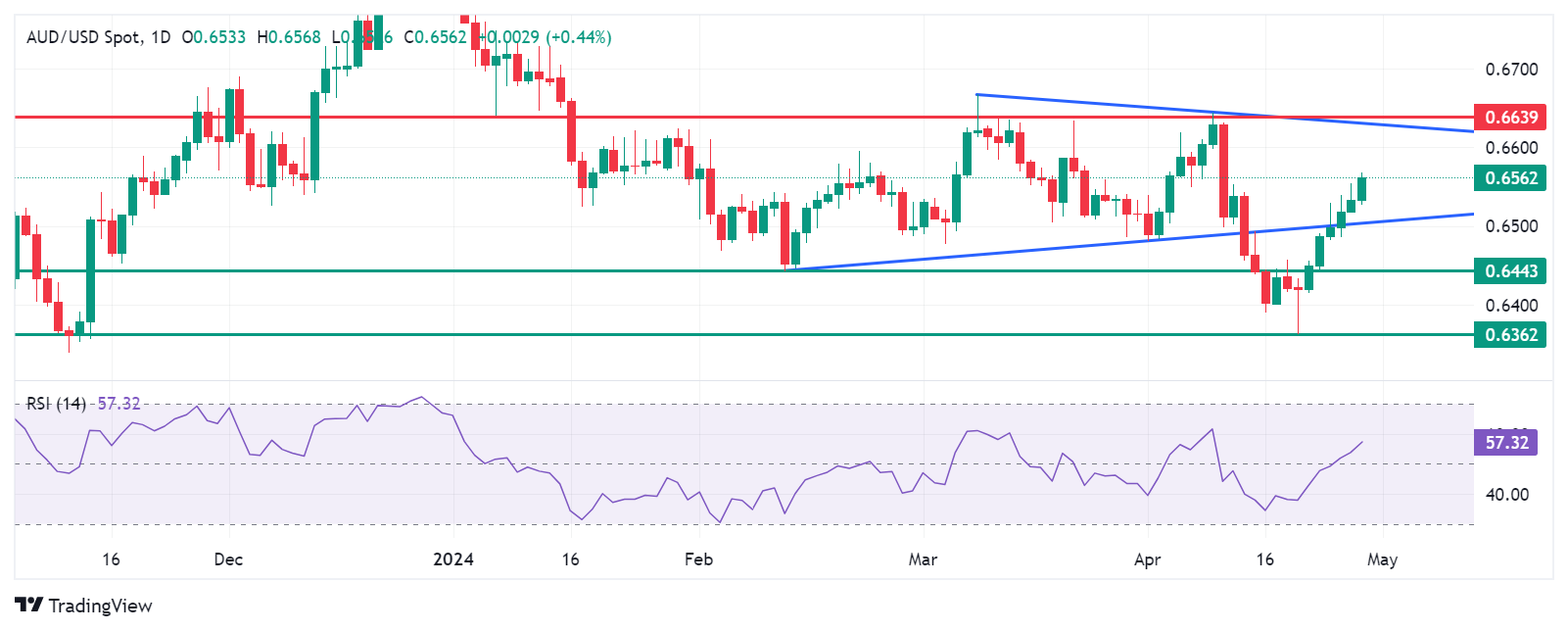- The Australian Dollar appreciates, propelled by an increasing hawkish sentiment surrounding the RBA.
- Australia’s Retail Sales could provide insight into consumer spending habits on Tuesday.
- The US Dollar retraces its recent gains due to the possible shift toward risk-on sentiment.
The Australian Dollar (AUD) continued its winning streak on Monday that began on April 22, trading around the three-week high of 0.6560. The AUD's upward momentum is fueled by increasing hawkish sentiment surrounding the Reserve Bank of Australia (RBA), spurred by last week's CPI inflation data surpassing expectations.
The Australian Financial Review reported that Warren Hogan, chief economic adviser at Judo Bank, anticipated that the RBA could implement three cash rate hikes throughout 2024, ultimately reaching 5.1%, with the initial increase likely occurring in August. Investors are likely awaiting the March Retail Sales data, scheduled for release on Tuesday, as it provides insight into Australia's consumer spending habits, which significantly impact inflation and GDP trends.
The US Dollar Index (DXY), which measures the performance of the US Dollar (USD) against six major currencies, retraces its recent gains, possibly reflecting a shift toward risk-on sentiment in the market. However, market analysts anticipate that the US Federal Reserve (Fed) will maintain the current interest rate range of 5.25%–5.5% in its upcoming announcement on Wednesday, likely due to concerns over elevated inflation levels. According to the CME FedWatch Tool, the likelihood of the Federal Reserve's (Fed) interest rates remaining unchanged in the June meeting has risen to 87.7%, up from last week’s 81.7%.
On Friday, the annual US Core Personal Consumption Expenditures (PCE) Price Index data for March showed an uptick, adding weight to the notion that the Fed may delay any potential rate cuts until September, as indicated by market speculation.
Daily Digest Market Movers: Australian Dollar appreciates on growing hawkish sentiment surrounding RBA
- Monday saw a strong surge in Australia's stock market, driven by a bullish performance on Wall Street. The ASX 200 Index extended its gains on Monday, with all 11 industry sectors recording gains following the positive momentum on Wall Street on Friday, which was fueled by impressive earnings reports from tech giants like Microsoft and Alphabet, the parent company of Google, pushing the Nasdaq up by over 2%.
- TD Securities' recent revision indicated a delay in the expected rate cut by the Reserve Bank of Australia (RBA) until February 2025, shifting from the previously projected date in November. This update has strengthened the Australian Dollar (AUD), consequently boosting the AUD/JPY pair.
- US Personal Consumption Expenditures (PCE) - Price Index increased 0.3% month-over-month in March, the same as in February, and matching market forecasts. The annual rate edged up to 2.7%, above forecasts of 2.6%.
- The US Core PCE - Price Index, the Fed’s preferred gauge to measure inflation, rose by 2.8% YoY in March 2024. Figures came above market forecasts of 2.6%. On a monthly basis, Core PCE increased by 0.3%, matching February's reading and in line with market estimates.
- In the first quarter, the US Gross Domestic Product Annualized (Q1) expanded at a slower pace, falling short of market expectations. The deceleration in GDP growth suggests potential headwinds or slowdowns in various sectors of the economy.
- Australia’s Consumer Price Index (CPI) increased to an all-time high of 137.40 points in the first quarter of 2024 from 136.10 points in the fourth quarter of 2023.
Technical Analysis: Australian Dollar holds position around 0.6550
The Australian Dollar trades around 0.6560 on Monday. The pair has extended its advance within a symmetrical triangle formation, with the 14-day Relative Strength Index (RSI) positioned above the 50-level, affirming a bullish stance.
In terms of potential upward targets, the AUD/USD pair may set its sights on the psychological barrier at 0.6600 and subsequently aim for the upper boundary of the triangle, situated around 0.6639.
On the downside, immediate support is anticipated around the psychological threshold of 0.6500. Should this level be breached, it could pave the way for further downside momentum, with the subsequent notable support zone lying around 0.6443, followed by additional support levels at April’s low of 0.6362.
AUD/USD: Daily Chart
Australian Dollar price today
The table below shows the percentage change of the Australian Dollar (AUD) against listed major currencies today. The Australian Dollar was the strongest against the US Dollar.
| USD | EUR | GBP | CAD | AUD | JPY | NZD | CHF | |
| USD | -0.21% | -0.25% | -0.15% | -0.63% | -1.33% | -0.55% | -0.32% | |
| EUR | 0.21% | -0.05% | 0.05% | -0.42% | -1.11% | -0.34% | -0.11% | |
| GBP | 0.26% | 0.05% | 0.11% | -0.38% | -0.94% | -0.29% | -0.06% | |
| CAD | 0.15% | -0.06% | -0.11% | -0.48% | -1.05% | -0.41% | -0.18% | |
| AUD | 0.63% | 0.42% | 0.36% | 0.48% | -0.68% | 0.08% | 0.31% | |
| JPY | 1.26% | 1.02% | 0.98% | 1.11% | 0.61% | 0.68% | 0.93% | |
| NZD | 0.56% | 0.35% | 0.29% | 0.40% | -0.07% | -0.76% | 0.24% | |
| CHF | 0.38% | 0.15% | 0.09% | 0.21% | -0.26% | -0.95% | -0.18% |
The heat map shows percentage changes of major currencies against each other. The base currency is picked from the left column, while the quote currency is picked from the top row. For example, if you pick the Euro from the left column and move along the horizontal line to the Japanese Yen, the percentage change displayed in the box will represent EUR (base)/JPY (quote).
Australian Dollar FAQs
One of the most significant factors for the Australian Dollar (AUD) is the level of interest rates set by the Reserve Bank of Australia (RBA). Because Australia is a resource-rich country another key driver is the price of its biggest export, Iron Ore. The health of the Chinese economy, its largest trading partner, is a factor, as well as inflation in Australia, its growth rate and Trade Balance. Market sentiment – whether investors are taking on more risky assets (risk-on) or seeking safe-havens (risk-off) – is also a factor, with risk-on positive for AUD.
The Reserve Bank of Australia (RBA) influences the Australian Dollar (AUD) by setting the level of interest rates that Australian banks can lend to each other. This influences the level of interest rates in the economy as a whole. The main goal of the RBA is to maintain a stable inflation rate of 2-3% by adjusting interest rates up or down. Relatively high interest rates compared to other major central banks support the AUD, and the opposite for relatively low. The RBA can also use quantitative easing and tightening to influence credit conditions, with the former AUD-negative and the latter AUD-positive.
China is Australia’s largest trading partner so the health of the Chinese economy is a major influence on the value of the Australian Dollar (AUD). When the Chinese economy is doing well it purchases more raw materials, goods and services from Australia, lifting demand for the AUD, and pushing up its value. The opposite is the case when the Chinese economy is not growing as fast as expected. Positive or negative surprises in Chinese growth data, therefore, often have a direct impact on the Australian Dollar and its pairs.
Iron Ore is Australia’s largest export, accounting for $118 billion a year according to data from 2021, with China as its primary destination. The price of Iron Ore, therefore, can be a driver of the Australian Dollar. Generally, if the price of Iron Ore rises, AUD also goes up, as aggregate demand for the currency increases. The opposite is the case if the price of Iron Ore falls. Higher Iron Ore prices also tend to result in a greater likelihood of a positive Trade Balance for Australia, which is also positive of the AUD.
The Trade Balance, which is the difference between what a country earns from its exports versus what it pays for its imports, is another factor that can influence the value of the Australian Dollar. If Australia produces highly sought after exports, then its currency will gain in value purely from the surplus demand created from foreign buyers seeking to purchase its exports versus what it spends to purchase imports. Therefore, a positive net Trade Balance strengthens the AUD, with the opposite effect if the Trade Balance is negative.
Information on these pages contains forward-looking statements that involve risks and uncertainties. Markets and instruments profiled on this page are for informational purposes only and should not in any way come across as a recommendation to buy or sell in these assets. You should do your own thorough research before making any investment decisions. FXStreet does not in any way guarantee that this information is free from mistakes, errors, or material misstatements. It also does not guarantee that this information is of a timely nature. Investing in Open Markets involves a great deal of risk, including the loss of all or a portion of your investment, as well as emotional distress. All risks, losses and costs associated with investing, including total loss of principal, are your responsibility. The views and opinions expressed in this article are those of the authors and do not necessarily reflect the official policy or position of FXStreet nor its advertisers. The author will not be held responsible for information that is found at the end of links posted on this page.
If not otherwise explicitly mentioned in the body of the article, at the time of writing, the author has no position in any stock mentioned in this article and no business relationship with any company mentioned. The author has not received compensation for writing this article, other than from FXStreet.
FXStreet and the author do not provide personalized recommendations. The author makes no representations as to the accuracy, completeness, or suitability of this information. FXStreet and the author will not be liable for any errors, omissions or any losses, injuries or damages arising from this information and its display or use. Errors and omissions excepted.
The author and FXStreet are not registered investment advisors and nothing in this article is intended to be investment advice.
Recommended content
Editors’ Picks

AUD/USD rises despite stronger US Dollar, eyes on Michigan sentiment
The Australian Dollar receives support from rising commodity prices, including Gold, Steel, and Iron Ore on Friday. However, The AUD/USD pair could face pressure from a strengthening US Dollar amid growing fears of a global economic slowdown.

EUR/USD: A move to 1.1000 re-emerges on the horizon
EUR/USD enjoyed a broadly upbeat run last week, extending its strong recovery and briefly surpassing the 1.0900 handle to reach multi-month highs. Although the rally lost some momentum as the week wore on, the pair still ended with a solid performance on the weekly chart.

Gold: Bulls act on return of risk-aversion, lift XAU/USD to new record-high
Gold capitalized on safe-haven flows and set a new record high above $3,000. The Fed’s policy announcements and the revised dot plot could influence Gold’s valuation. The near-term technical outlook suggests that the bullish bias remains intact.

Week ahead: Central banks in focus amid trade war turmoil
Fed decides on policy amid recession fears.Yen traders lock gaze on BoJ for hike signals. SNB seen cutting interest rates by another 25bps. BoE to stand pat after February’s dovish cut.

Week ahead – Central banks in focus amid trade war turmoil
Fed decides on policy amid recession fears. Yen traders lock gaze on BoJ for hike signals. SNB seen cutting interest rates by another 25bps. BoE to stand pat after February’s dovish cut.

The Best brokers to trade EUR/USD
SPONSORED Discover the top brokers for trading EUR/USD in 2025. Our list features brokers with competitive spreads, fast execution, and powerful platforms. Whether you're a beginner or an expert, find the right partner to navigate the dynamic Forex market.
